Shopify vs Wix: Finding your online store’s perfect match
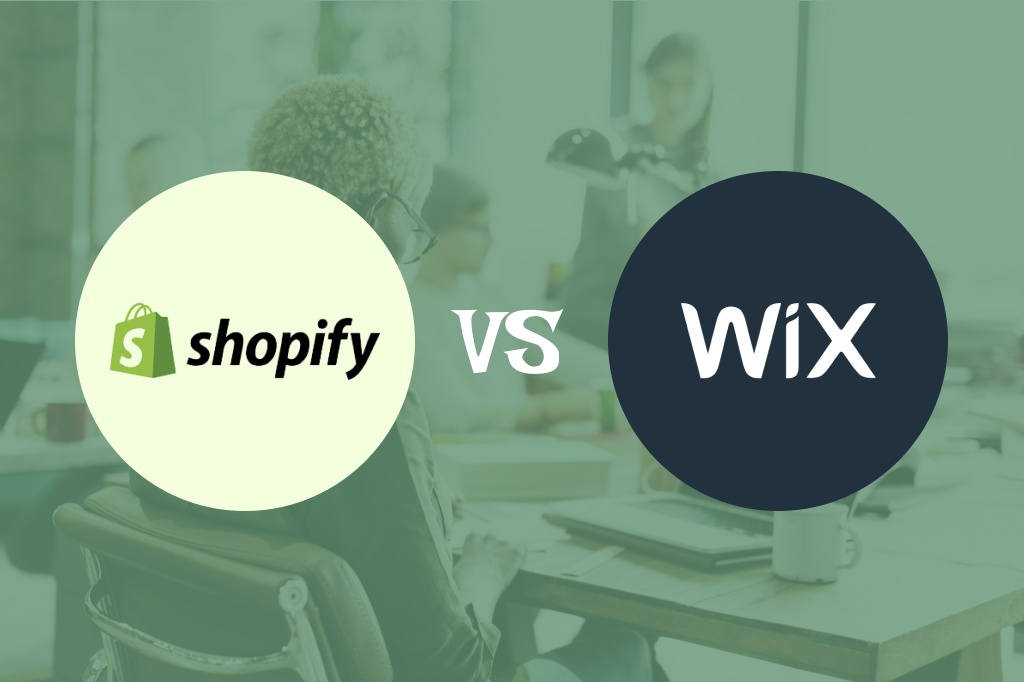
Shopify vs Wix: Which is the absolute best? Is it better to use Shopify or Wix? Is Wix good for eCommerce?
When it comes to starting an online store, the choice between Shopify and Wix can be overwhelming and tricky. Both platforms enable you to create a website and sell products and services online, but they have distinct features and focus areas.
Shopify is a dedicated eCommerce website builder that is specifically designed for building online stores. It offers a wide range of powerful sales tools, eCommerce features, third-party apps, and scalability.
Wix, on the other hand, is a user-friendly, drag-and-drop website builder with an eCommerce solution introduced in 2020. It’s great for content sites like blogs and offers a simpler and more budget-friendly option for online stores compared to Shopify.
To help you make an informed decision, we’ve compared and evaluated them based on four main aspects: pricing, ease of use, eCommerce capabilities, and growth potential.
Let’s dive in and discover which one is the best fit for your eCommerce needs.
1. Shopify vs Wix: Side-by-side comparison overview
| Shopify | Wix | |
| Description | A specialized eCommerce platform, cater to businesses of all sizes with a strong emphasis on robust online sales and scalability | A versatile website builder, ideal for small businesses and individuals seeking user-friendly, flexible website design with basic eCommerce functionality |
| Pricing | – Basic: $25/month ($19 annually) – Shopify: $65/month (49 annually) – Advanced: $399/month ($299 annually) – 3-day free trial, then enjoy $1/month for 3 months | Have both free plan & premium plan, but eCommerce functionality is only available with Business and Ecommerce plans, which include the following options: – Business basic: $17/month – Business unlimited: $25/month – Business VIP: $35/month – 14-day free trial |
| Transaction fees | (None for using Shopify payment) Third-party payment provider: – Basic: 2% – Shopify: 1% – Advanced: 0,5% | No transaction fees for Wix Payments or third-party gateways |
| Credit card rate fees | – Basic: 2.9% + 30 cents per transaction – Shopify: 2.6% + 30 cents per transaction – Advanced: 2.4% + 30 cents per transaction | Vary by country 2.9% + 30c in the US |
| Ease of use | User-friendly, using sections and blocks to set up site | User-friendly, using drag-and-drop to set up a site |
| Design & templates | – 116 eCommerce themes, 11 free. – Others priced $180-$350. – CSS/HTML access for flexibility – Easy theme switching | – 800+ templates, 114 for eCommerce, all free. – No main code editing – Need to rebuild the store for a new theme |
| Payment | Multiple gateways, diverse checkout options | Simpler checkout process with Wix Payments and third-party gateways |
| Shipping | – Stand out with a built-in solution, Shopify Shipping – Integrate with third-party fulfillment services | Limited native shipping solution, relies on third-party apps |
| Fulfillment | Extensive options for order fulfillment | Simpler fulfillment, suitable for smaller businesses |
| Dropshipping | – Highly optimized platform for dropshipping – 489 apps for dropshipping | – Limited support for dropshipping – 36 apps for dropshipping |
| Integration | Extensive app marketplace with 8,000+ apps | 300+ apps, with only 48 focused on eCommerce |
| Product | – Supports unlimited product capacity – 3 product options and 100 variants, can be expanded with third-party apps | – Supports a maximum of 50,000 products 6 product options and 1,000 variants |
| POS | – Shopify POS can be used worldwide, in any country where Shopify has supported credit card payment providers – More comprehensive features and is suitable for a wide range of businesses, from small retailers to larger enterprises | – Wix POS is available to users based in the U.S. and Canada who are connected to Wix Payments only – Wix POS is suited for small businesses with basic needs. |
| Marketing capability | Many customization options, extensive app integrations, and a broader reach with diverse sales channels | A comprehensive suite of marketing tools with a user-friendly interface |
| International focus | Good for businesses with a strong international focus due to its comprehensive multi-currency support and advanced international features | Limited multi-currency and international support, making it less suitable for businesses aiming for extensive global operation |
| Scalability | Highly scalable, suitable for businesses of all sizes | More suited for small to medium-sized businesses, may have limitations for larger enterprises |
The key difference between Shopify and Wix
The key difference between Shopify and Wix is their primary focus and core strengths. Shopify is primarily an eCommerce platform with a strong focus on providing robust online sales and scalability, making it ideal for businesses of all sizes, from small to large enterprises. It excels in offering advanced eCommerce features, transaction options, shipping, and fulfillment capabilities.
On the other hand, Wix is a versatile website builder that can accommodate a wide range of website needs. While it does include eCommerce features, its primary strength lies in its user-friendliness and design flexibility. Wix is best suited for small businesses and individuals who prioritize ease of use and the ability to create and design websites quickly and straightforwardly.
>>> Learn more: Shopify vs Etsy: Which is Best for Startups?
2. Wix vs Shopify: Which one is better for your online store?
2.1. Wix: Pros & Cons
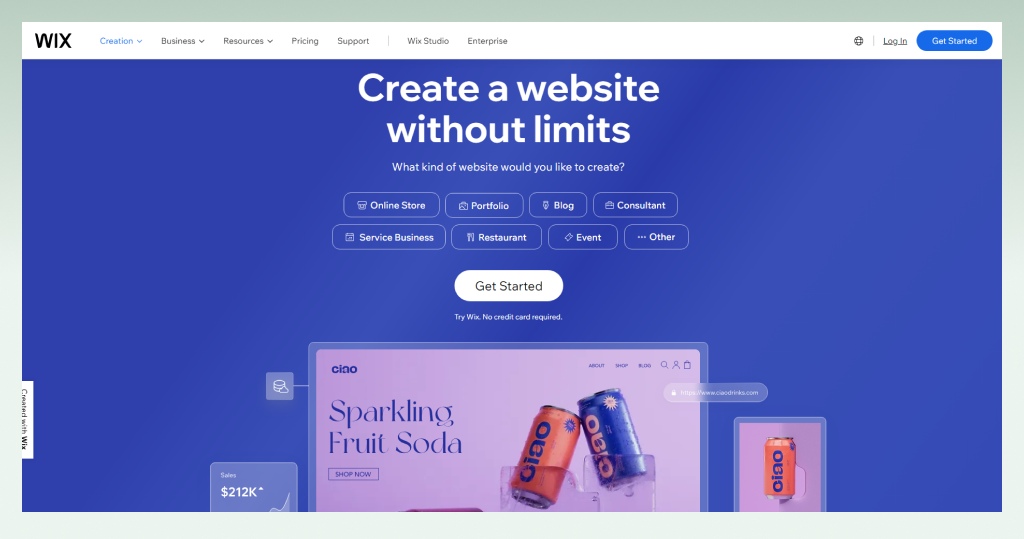
Pros
User-Friendly: Wix is extremely user-friendly, allowing for quick website setup using a drag-and-drop interface.
Design Flexibility: It offers design flexibility with a wide range of templates, making it suitable for various website needs.
Simplicity: The platform simplifies the checkout process for users.
No Transaction Fees: Wix doesn’t charge transaction fees for using either Wix Payments or third-party gateways.
Ideal for Small Businesses: Wix is a great choice for small businesses with basic eCommerce needs.
Integrated Marketing: It provides a comprehensive suite of marketing tools with a user-friendly interface.
Cons
Limited International Support: Wix has limited support for multi-currency and international features, making it less suitable for businesses with strong international operations.
Not Ideal for Complex E-commerce: It may not be the best choice for large businesses or those with complex eCommerce requirements.
Limited Product Capacity: Wix has a maximum limit of 50,000 products, which might not be sufficient for larger eCommerce businesses.
2.2. Shopify: Pros & Cons

Pros
E-commerce Focus: Shopify is a specialized eCommerce platform, designed for businesses of all sizes, with a strong focus on robust online sales and scalability.
Comprehensive E-commerce Features: It offers a wide range of eCommerce features and integrations, making it suitable for businesses with complex online sales needs.
High Customization: Shopify provides extensive customization options, with access to CSS and HTML for theme editing.
Scalability: It is highly scalable and suitable for small to large businesses.
Advanced Shipping and Fulfillment: Shopify offers advanced shipping and order fulfillment options, including third-party integrations.
Strong Dropshipping Support: It’s optimized for dropshipping, with numerous specialized apps available.
Robust App Marketplace: Shopify has a vast app marketplace with over 8,000 apps catering to diverse business needs.
Multi-Currency Support: Ideal for businesses with a strong international focus, offering comprehensive multi-currency support and advanced international features.
Cons
Learning Curve: The platform might have a steeper learning curve, particularly for users new to eCommerce concepts.
Transaction Fees: Shopify charges transaction fees for third-party payment providers, which can affect costs for some businesses.
Complexity for Smaller Businesses: Small businesses with basic needs might find Shopify’s features overwhelming.
Theme Costs: While some themes are free, others can be relatively expensive, with prices ranging from $180 to $350 as a one-time payment.
The choice between Wix and Shopify depends on your specific business needs, familiarity with eCommerce, and preferences for design and features.
2.3. Choose Wix if you need
User-Friendly Website Building: If you prioritize an easy-to-use platform with drag-and-drop design, Wix is tailored to your needs. It’s perfect for beginners and individuals who want a straightforward website-building experience.
Basic E-commerce Needs: Wix is suitable for small businesses and individuals with basic eCommerce requirements. If you’re not heavily focused on online sales and don’t require complex features, it’s a user-friendly choice.
Affordability: Wix offers cost-effective plans, making it an excellent choice for budget-conscious users who need a simple online store without advanced eCommerce features.
Integrated Marketing: If you seek an all-in-one solution to streamline marketing tasks and enhance customer engagement.
2.4. Choose Shopify if you need
Advanced E-commerce Features: If you require robust eCommerce features, such as multi-currency support, advanced inventory management, and a wide range of payment gateways, Shopify is a strong contender. It’s designed for businesses with complex eCommerce needs.
Multi-Channel Selling: If you plan to sell your products not only through your online store but also on various sales channels like Facebook, Instagram, and Pinterest, Shopify’s multi-channel selling capabilities can be a significant advantage.
Global Reach: If your business has an international focus and you need features like multi-currency support, international shipping, and extensive language options, Shopify offers comprehensive solutions for global expansion.
Extensive App Ecosystem: Shopify’s app store provides access to a vast selection of third-party apps and integrations, allowing you to customize and expand your store’s functionality according to your specific requirements.

3. Shopify or Wix? 5 key factors to help you decide
3.1. Shopify vs Wix: Pricing & fees
Subscription Plans
Wix
Wix offers both free and premium plans. You can start with a free Wix plan, but it comes with limitations. With a Premium plan, you can connect your own domain, remove Wix branding from your site, and enable eCommerce features. There are seven paid plans available with a 14-day trial.
Four Wix Website plans are tailored for those who need professional websites but don’t require online payments. These plans include:
- Connect Domain: $4.5/month
- Combo: $8.5/month
- Unlimited: $12.5/month
- VIP: $24.5/month
All these plans come with a custom domain and storage ranging from 500MB to 35GB (higher for premium plans). The Connect Domain plan does not remove Wix branding, and the Combo plan does not include a logo created by Wix.
To enable eCommerce and accept online payments on your Wix website, you’ll need to choose from three Wix Business and E-commerce plans:
- Business Basic: $17/month
- Business Unlimited: $25/month
- Business VIP: $35/month
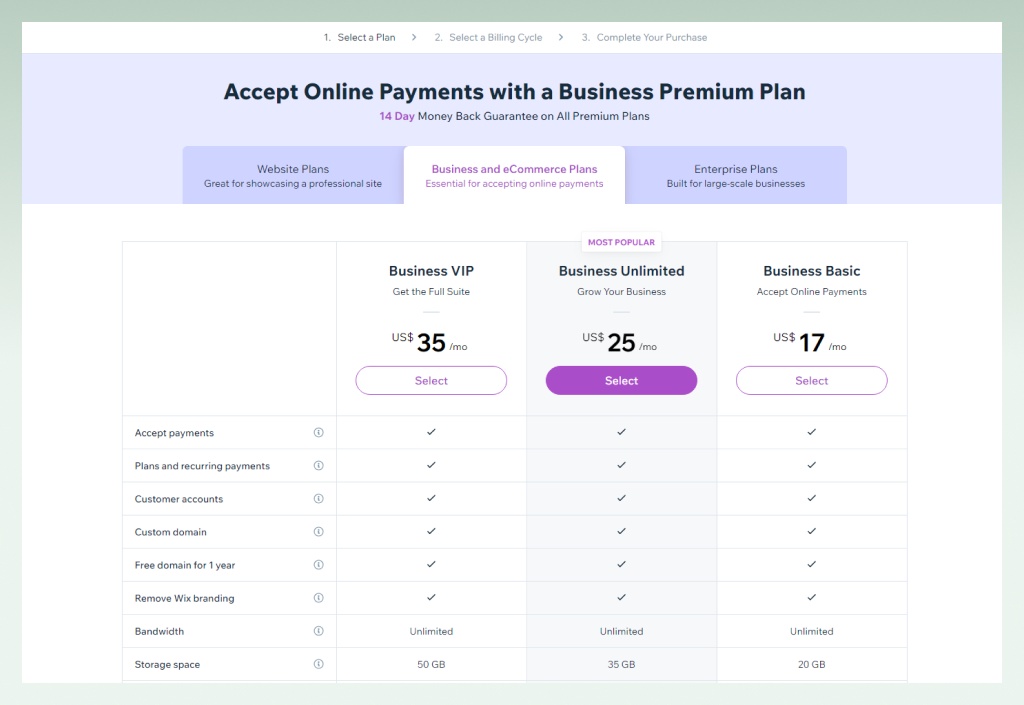
These eCommerce plans include features like accepting payments, customer accounts, custom domains, storage ranging from 20-50GB (varies by plan), support for up to 50,000 products, abandoned cart recovery, and the ability to sell on social channels. Notably, the Business Basic plan lacks customized reports, support for multiple currencies, and selling on marketplaces, while the Business Unlimited plan does not include customized reports and a loyalty program by Smile.io.
Shopify
Shopify offers a 3-day free trial without requiring a credit card. To create an eCommerce website and blog, you can choose from the following plans:
- Basic Plan (For Individuals & Small Businesses): $25 per month ($19 annually). Includes a website and blog, 2 staff accounts, and 24/7 support.
- Shopify Plan (For Small Businesses): $65 per month ($49 annually). Offers lower credit card rates, 5 staff accounts, professional reporting, POS (Point of Sale), and gift cards.
- Advanced Plan (For Medium to Large Businesses): $399 per month ($299 annually). Provides lower credit card rates, 15 staff accounts, a report builder upgrade, and reduced logistical costs with third-party calculated shipping.

Payment Processing Fees
Wix: Processing fees can vary depending on the currency your checkout is set up with, with default fees ranging from 1.9% to 2.9% in the European Union, Canada, Switzerland, the United Kingdom, and the United States.
Shopify: Shopify charges a small fee for accepting major credit cards, such as Visa and Mastercard. The fees vary based on the chosen plan:
- Basic Plan: 2.9% + 30 cents per transaction
- Shopify Plan: 2.6% + 30 cents per transaction
- Advanced Plan: 2.4% + 30 cents per transaction
Transaction Fees
Both Wix and Shopify allow you to avoid transaction fees by using their built-in payment processors, Wix Payments and Shopify Payments, respectively. However, if you opt for a third-party payment gateway, Shopify will apply transaction fees ranging from 0.5% to 2%. Wix, on the other hand, doesn’t charge any additional fees for using third-party gateways.
In summary, if you’re looking to build a content-focused website rather than an eCommerce site, Wix’s entry-level plan at $4.5/month offers better value. However, when evaluating the two products from an eCommerce perspective, it’s essential to consider the quality of selling features, where Shopify excels.
3.2. Shopify vs Wix: Ease of use (Setup, customer and learning resources)
Setup
Shopify and Wix are both known for their user-friendly approach to building an online store. Regardless of your background, whether you have coding or web design skills or not, both platforms offer a fantastic user experience. They provide clear, well-written, and easy-to-understand guidance from onboarding through each step of the process. However, Wix is often seen as easier to set up, particularly for small businesses. Let’s explore this comparison in detail.
Wix is designed for creating a professional online presence, with a focus on visually appealing, content-rich sites that include business descriptions, blogs, and articles. It does offer basic eCommerce functions for accepting payments, although it wasn’t originally built for hosting online stores. On the other hand, Shopify is a dedicated eCommerce platform, optimized for online store management and sales. It does include features like blogs and business descriptions, but they aren’t its primary focus.
This difference partly explains why starting with Shopify may require a bit more effort than with Wix. Creating a basic business website is typically simpler than launching a full-fledged online store. This is because an online store requires more decisions about payment gateways, tax calculations, product variations, shopping cart functionality, shipping options, and return policies, just to get started.
Moreover, Wix is often considered easier to set up, partly because of its drag-and-drop functionality. You can simply drag and drop elements to create your store, making the process quick and straightforward. Even if you have no coding skills, you can easily make things look the way you want, and any changes you make will appear exactly the same in your final store.

Source: Wix editor
In contrast, Shopify uses sections and blocks to set up your site. But, you may have to switch between the front-end and back-end for certain features, which can disrupt the flow of building your store.

Source: Shopify editor
Wix is simpler to start with than Shopify, but both platforms are generally user-friendly. The ease of setting up your store on either platform depends on factors like your customization needs and the number of products you plan to sell. Using a basic template or theme, you can have a Shopify store ready in a few hours, whereas a more complex setup might take a few days.
Here’s a clear recommendation: If you’re starting a small online business with a limited product range and need a straightforward eCommerce platform for a quick launch, go for Wix. On the other hand, if you aim to create a scalable online store with flexible eCommerce features, Shopify is the better choice.
Support and learning resources
When it comes to getting assistance and support for your online store, having the right resources readily available is crucial. Both Shopify and Wix offer a range of helpful options for eCommerce businesses, including:
Knowledge Bases: Both platforms have comprehensive knowledge bases filled with articles and information to help you troubleshoot issues and learn how to use their features effectively.
Community Forums: Shopify and Wix provide community forums where you can connect with other users, ask questions, and share experiences.
Tutorials and Guides: You’ll find various tutorials and guides that walk you through different aspects of building and managing your online store on both platforms.
Customer Support: Both platforms offer 24/7 customer support through various channels, including live chat, email, and phone. This ensures that you can get help whenever you need it.
For more complex issues or if you need assistance beyond the basics, Shopify offers ‘Shopify Experts.’ These are freelancers and agencies you can hire to help with technical challenges, content marketing, and other advanced aspects of running your store.
Wix has a comparable platform called ‘Wix Marketplace,’ where you can hire services for various stages of your business, making it easy to find expert help when needed.
In essence, both platforms are well-equipped in terms of support and learning resources to ensure you have the assistance you need, whether you’re a beginner or tackling more advanced challenges in your eCommerce journey.
3.3. Shopify vs Wix: Design & templates
Templates
Creating attractive eCommerce websites is straightforward with both Wix and Shopify, but which one is the superior choice? To help you decide, let’s begin by comparing the template options they offer.
Wix shines with an impressive array of 800+ templates, which includes 114 tailored for eCommerce. The best part? All of Wix’s templates are absolutely free.
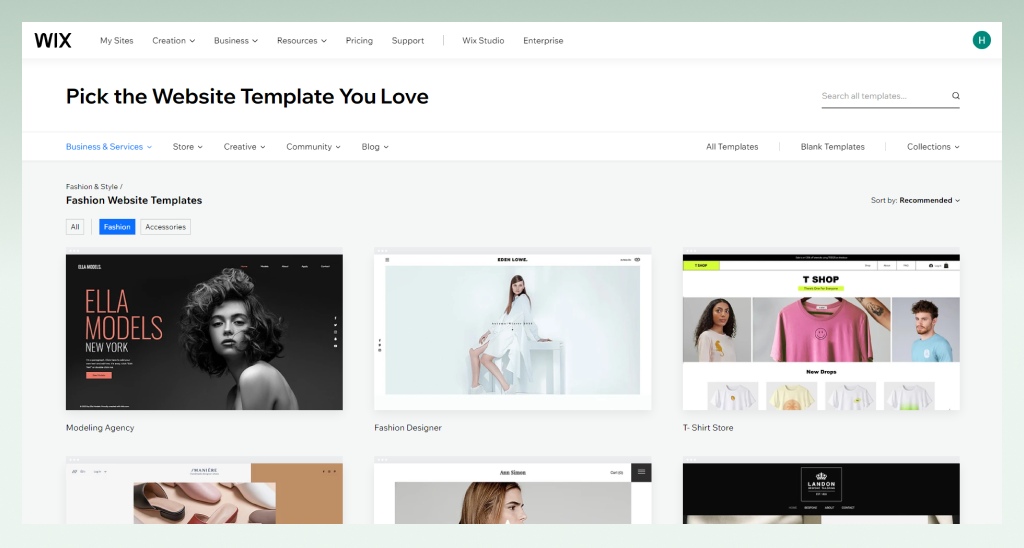
In comparison, Shopify offers 116 themes, with 11 available for free. The rest will cost you between $180 and $350 as a one-time payment. So, if you’re looking to keep web design costs low, Wix is the more budget-friendly option.

However, it’s important to note that Shopify themes are up-to-date, versatile, and crafted by creative designers. They cater to various industries, such as restaurants, sports, and pet supplies. Most Shopify themes also offer multiple styling options, allowing you to choose the one that aligns best with your brand. This is a valuable investment in building a professional and scalable store.
Moreover, if you want to make significant changes to your theme, Shopify offers more flexibility. You get complete access to its CSS and HTML, letting you change almost anything. On the other hand, while Wix allows you to add CSS and HTML blocks, you can’t edit the main code or style sheets.
If you think you might switch to a different theme later on, Shopify is the better choice. Changing themes in Shopify is easy with just a few clicks. In contrast, if you want to change to a new template with Wix, you’ll have to rebuild your entire store.
Responsive
Shopify and Wix have mobile-friendly themes, but Shopify has an edge here. Shopify themes are designed to work seamlessly on both desktop and mobile screens. When you switch to a mobile view, Shopify automatically adjusts the page layout, making everything still appear fantastic.
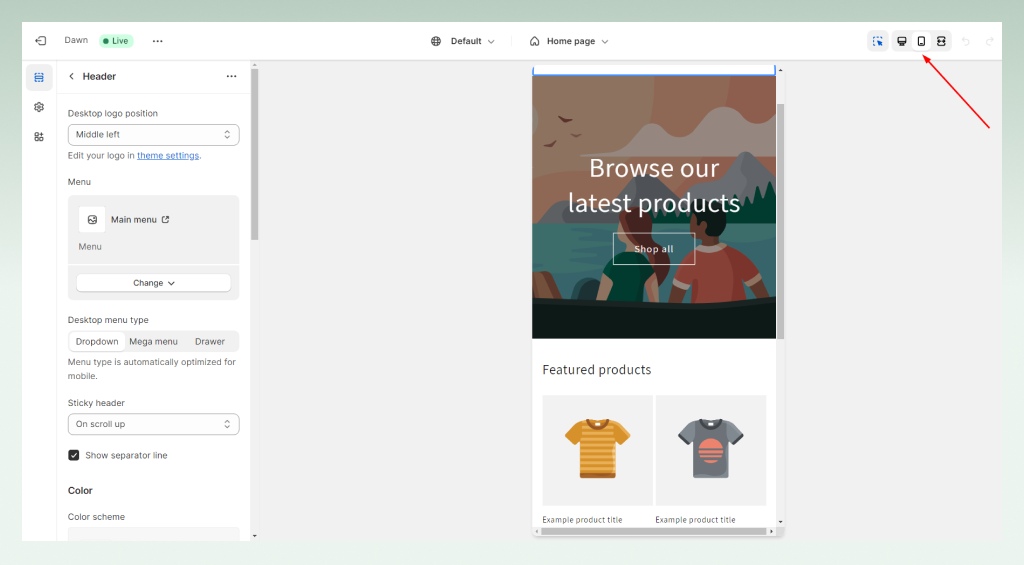
Source: Shopify editor
On the other hand, with Wix, you might need to manually tweak things to make the mobile version look right.
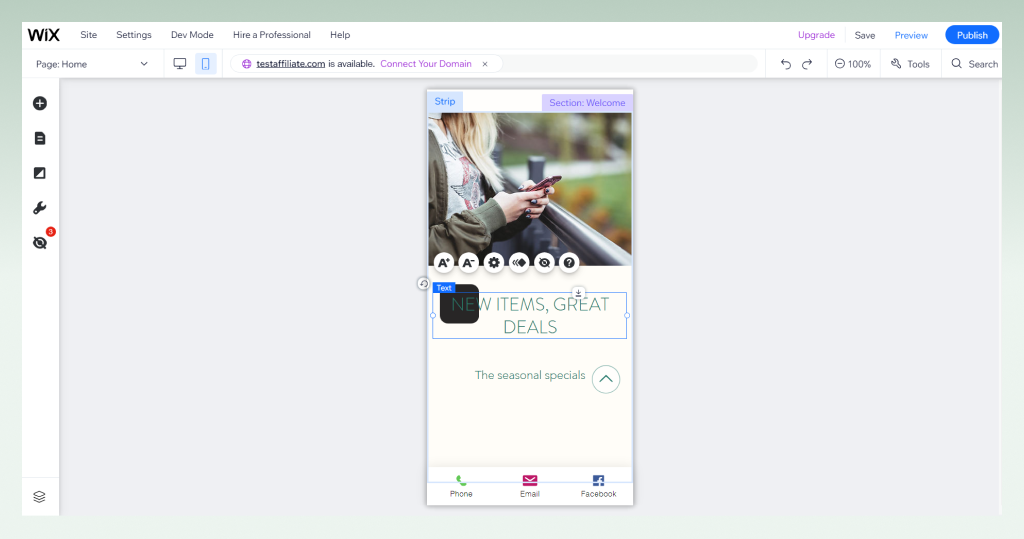
Source: Wix editor
In summary, when choosing between Wix and Shopify for your eCommerce website, your decision should be based on your budget and customization requirements. Wix is a more budget-friendly option for getting started, but if you prioritize flexibility and automatic mobile responsiveness, Shopify comes out as the winner.
3.4. Shopify vs Wix: eCommerce features
Payment
Shopify and Wix offer various payment choices for your customers, including popular options like PayPal and Stripe, as well as their in-house payment gateways, such as Shopify Payments and Wix Payments.
The availability of these gateways depends on your location. You can check if they are offered in your country by visiting these links:
One advantage that Wix holds over Shopify is that it does not charge transaction fees for either its own payments or third-party gateways. In contrast, Shopify only provides fee-free transactions through Shopify Payments. For third-party gateways, Shopify applies fees depending on your plan: 2%, 1%, and 0.5% for the Basic, Shopify, and Advanced plans, respectively.
Shipping
Both Shopify and Wix offer a range of shipping options and features, including various delivery methods, order tracking, customizable shipping rates, and support for third-party app integrations.
However, Shopify stands out with its built-in solution, Shopify Shipping, which provides easy access to discounts of up to 88% on shipping rates from major carriers like UPS, USPS, and DHL. It also offers real-time carrier-calculated shipping rates and the convenience of printing and purchasing labels directly within the Shopify platform.
In contrast, Wix does not provide a native shipping solution like Shopify Shipping. To access real-time rates and carrier discounts, Wix users must rely on third-party apps such as Shippo.
Consequently, Shopify excels in terms of real-time shipping rates and carrier discounts, making it a strong choice for businesses with shipping needs.

Fulfillment
When it comes to order fulfillment, both Shopify and Wix offer solutions, but the key difference lies in the level of complexity. Shopify provides a robust platform that caters to businesses of all sizes, with extensive customization options and support for third-party fulfillment services. This scalability makes it suitable for a wide range of enterprises. On the other hand, Wix offers a more straightforward approach to order fulfillment, ideal for smaller businesses and those who prefer a user-friendly experience. The choice between the two should be based on the complexity of your fulfillment needs and the scale of your business.
Dropshipping
Dropshipping is a retail fulfillment method where a store doesn’t keep the products it sells in stock. Instead, when a store sells a product, it purchases the item from a third party and has it shipped directly to the customer. As a result, the merchant never sees or handles the product.
When it comes to dropshipping, Shopify is the go-to platform for its specialized apps. It’s easy to find dropshipping apps like Oberlo, Modalyst, and Spocket that seamlessly connect you with suppliers and products.
You can start dropshipping with Wix as well. In recent years, the company has integrated with platforms that facilitate dropshipping, connecting you with key suppliers like Modalyst, Spocket, and AliExpress.
However, it’s crucial to note that Wix offers only 36 apps for dropshipping, while Shopify boasts 489 supported apps. Therefore, Shopify outperforms Wix in terms of dropshipping, providing more resources and tools to launch a successful dropshipping store. Wix may not offer the same level of convenience and automation as Shopify.
In summary, if you’re seeking a highly optimized platform for dropshipping with a wide array of specialized apps, Shopify is the preferred choice.
Integration
When it comes to integration, both Shopify and Wix offer extensive app marketplaces with thousands of options, but there are some notable differences. Shopify boasts over 8,000 apps, a majority of which are eCommerce-specific, catering to various functions like dropshipping, inventory management, and customer retention.

In contrast, Wix’s App Market provides access to 300+ integrations, with only 48 focused on eCommerce.

Source: Wix app market
The reason for this gap is Shopify’s strong focus on eCommerce, which attracts a larger user base and, in turn, more app developers. While Shopify’s apps are primarily eCommerce-related, Wix offers a broader range, including those designed to enhance your website or blog.
In general, Shopify’s apps are designed to enhance your eCommerce capabilities, while Wix’s apps focus on improving your website or blog as a whole. If you run a large eCommerce business with an extensive product inventory, various product variations, or an international customer base, Shopify is better equipped to meet your specific needs.
Product
Wix is user-friendly and best for smaller online stores with straightforward product catalogs. It allows up to 6 product options and 1,000 variants. In comparison, Shopify starts with limits of 3 product options and 100 variants, but you can expand them with paid apps.
Additionally, Wix supports a maximum of 50,000 products in your online store. However, Shopify excels here, offering unlimited product capacity, making it suitable for businesses with extensive product catalogs and complex inventory needs.
In summary, if you want a simple approach to selling online and don’t plan to build a large business or offer many products, Wix is a good choice. But for more complex online stores, especially those with extensive inventories, Shopify is the better option.
POS
POS (Point of Sale) is a mobile and tablet-based point-of-sale system designed for businesses that sell both online and in physical retail locations, such as brick-and-mortar stores, pop-up shops, and events.
If you have a physical store, you’ll be glad to know that both Wix and Shopify offer their own POS solutions for integrating online and offline experiences. Both of them have some key features in common:
Omnichannel Sales: It enables businesses to manage both online and offline sales from a single platform, allowing them to track inventory, customer data, and sales across various channels.
Inventory Management: POS syncs your in-store and online inventory, ensuring that product availability is accurate and up-to-date. This helps prevent overselling and stockouts.
Sales Processing: You can use POS to accept credit card payments, cash, and other payment methods in your physical store.
Customer Management: The system allows you to manage customer profiles, track purchase history, and offer customer loyalty programs, making it easier to engage with your customers.
Staff Management: Manage your employees with access control, allowing you to assign different roles and permissions to your team.
Reporting and Analytics: Access sales reports and analytics to gain insights into your business’s performance.
POS Hardware: Cash Drawers, Receipt Printers, Barcode Scanners
However, they have some differences:
Shopify POS can be used worldwide, in any country where Shopify has supported credit card payment providers, while Wix POS is available to users based in the U.S. and Canada who are connected to Wix Payments only.
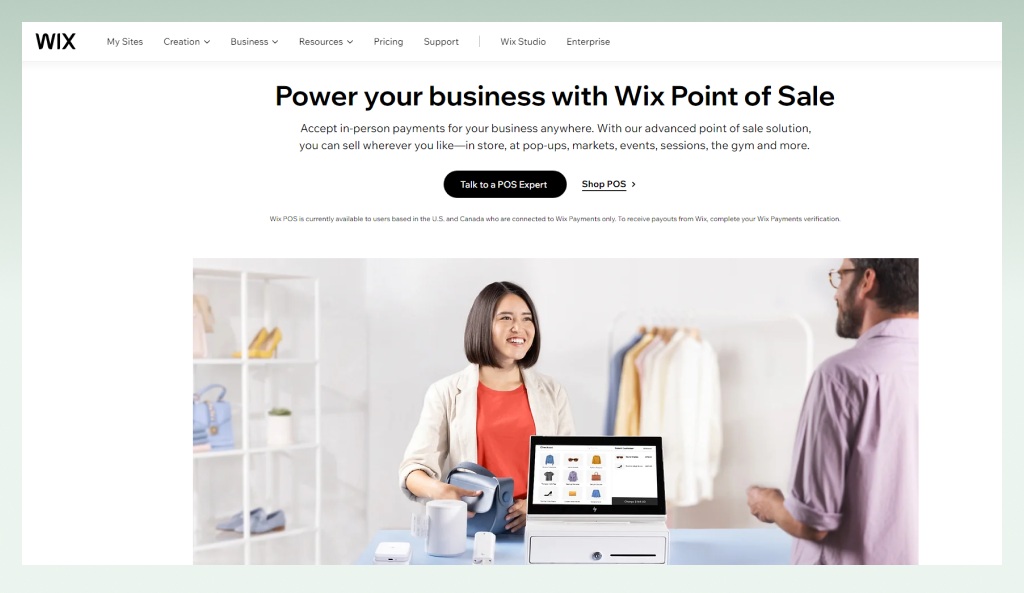
Shopify POS offers more comprehensive features and is suitable for a wide range of businesses, from small retailers to larger enterprises. Wix POS is suited for small businesses with basic needs.
Furthermore, Shopify wins over Wix with eCommerce integration. Shopify seamlessly integrates in-store and online sales, providing a unified solution for businesses. This allows for synchronized inventory management and offers various shopping options like local pickup, local delivery, and more. However, to access advanced eCommerce functionality, such as in-store pickup, staff logins, and smart inventory management, you can opt for the POS Pro plan, which costs $89/month or is free for Shopify Plus users.
On the other hand, Wix is a more cost-effective solution for businesses with basic needs. Wix POS offers some free extras, such as local delivery and staff accounts, which Shopify may charge for.
In summary, Shopify POS is known for its comprehensive features, global availability, and advanced eCommerce capabilities, making it suitable for businesses of all sizes. However, it can be more costly, especially for advanced features. In contrast, Wix POS is a cost-effective solution, particularly for businesses in the U.S. and Canada, but it may not offer the same level of feature richness and global reach as Shopify. Your choice between the two will depend on your specific business needs, location, and budget.
International focus
When evaluating Shopify and Wix from an international perspective, it’s crucial to assess several key factors, including their global reach, support for multiple languages, and currency handling. Here’s a comprehensive comparison of both platforms in an international context:
Multilingual Support
Both Wix and Shopify empower you to create multi-language versions of your websites, facilitating engagement with a diverse global audience.
Currency Support
The ability to sell in customers’ local currencies can significantly boost online sales and streamline the shopping experience.
Shopify takes the lead in this aspect by providing end-to-end multi-currency payment support. This allows customers to seamlessly browse, shop, and complete transactions in their preferred currency.
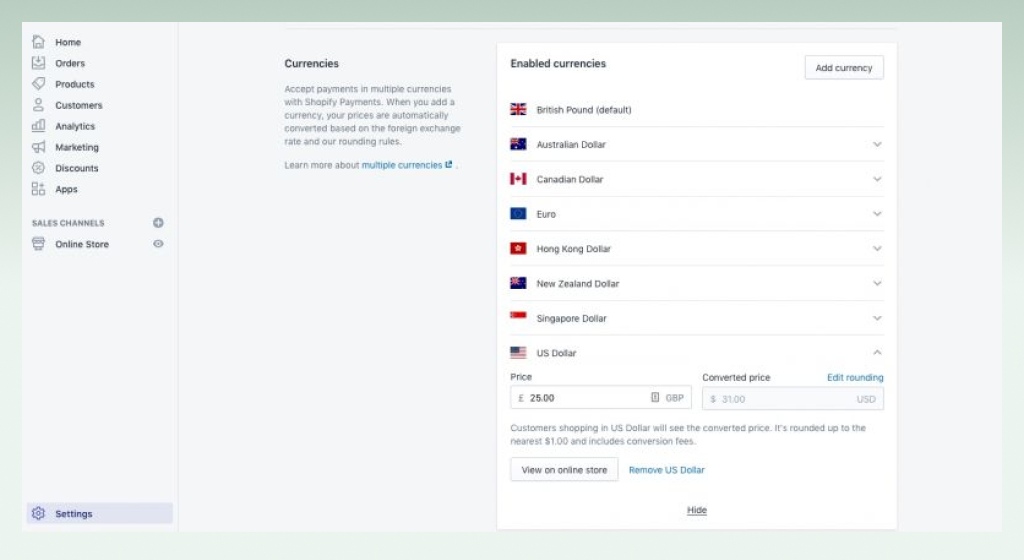
Conversely, Wix offers a currency converter drop-down menu for displaying prices in various currencies. However, it falls short as visitors cannot finalize their purchases in their own currency, potentially causing currency conversion issues during the checkout process.
Additional International Features
Shopify outshines Wix with a range of other international capabilities, including robust point-of-sale (POS) functionalities, a diverse selection of payment gateways (both regional and global), global shipping and fulfillment solutions, and tools for tailoring and localizing the shopping experience. This includes features like currency conversion, precise tax calculations, and adaptive shipping rates based on the buyer’s location.
In summary, Shopify emerges as the preferred choice for businesses with a strong international focus due to its comprehensive multi-currency support and advanced international features. While Wix offers multilingual support, it lags behind in terms of currency support for international customers. Your decision should align with your specific international business requirements and target markets.
Marketing capabilities
When it comes to marketing, the choice between Shopify and Wix depends on your specific marketing needs and your level of expertise. Here’s a breakdown to help you decide which platform is the better choice for marketing:
Shopify Marketing
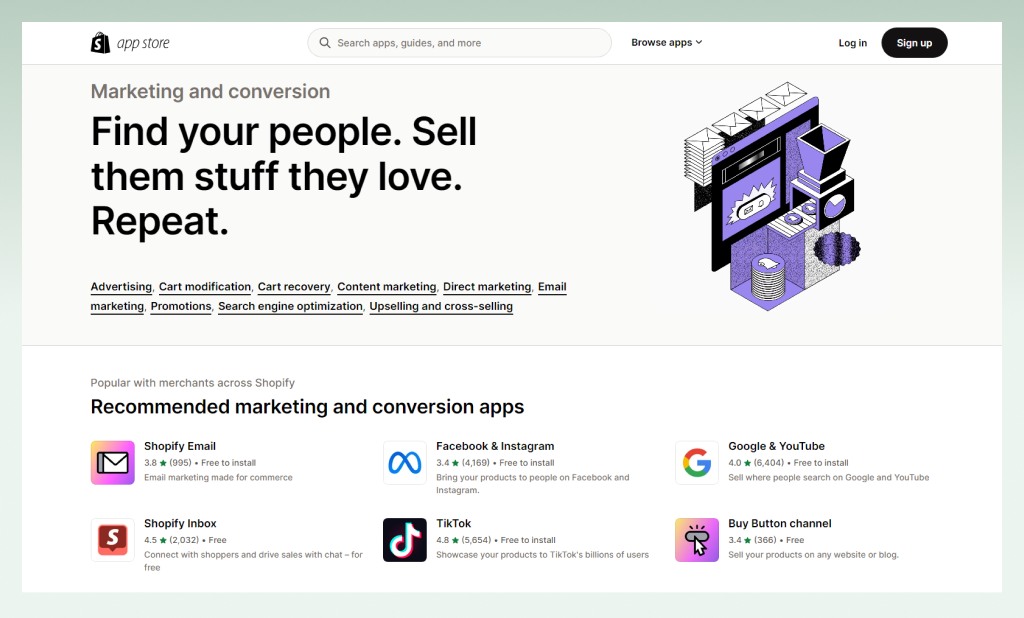
Extensive App Store: Shopify’s app store offers a wide range of marketing apps and integrations, allowing you to customize your marketing strategies. You can find apps for email marketing, social media advertising, SEO optimization, and more. This versatility makes it a strong choice for businesses with complex marketing needs.
Multi-Channel Selling: With Shopify, you can sell your products not only through your online store but also on various sales channels like Facebook, Instagram, Handshake,… This feature helps you expand your reach and tap into different audiences. Check more here
Email Marketing: Shopify offers email marketing tools to send targeted email campaigns to your customers. You can create and manage email marketing campaigns directly within the platform. Shopify also offers an abandoned cart recovery feature, which allows you to automatically send emails to customers who have abandoned their shopping carts. This can help recover potentially lost sales.
SEO: Shopify is great for SEO. It has a clean codebase for better search engine visibility. You can customize titles and meta tags. Your site looks good on any device. Plus, Shopify’s app store offers useful SEO tools.
Wix Marketing

Source: Wix admin
Wix Ascend: Wix offers a comprehensive marketing solution called Wix Ascend, available as a separate subscription. It allows you to manage your marketing campaigns from a centralized dashboard. This all-in-one solution simplifies marketing tasks.
Semrush Partnership: Wix has partnered with Semrush, giving you direct access to Semrush keyword data from your Wix dashboard. This can be a valuable tool for SEO and keyword optimization.
Multi-Channel Selling: With Etsy, you can sell your products through Google Merchants, eBay, Facebook Shop, and TikTok
Email Marketing: Similar to Shopify, Wix offers email marketing tools that help you create and send targeted email campaigns to your customers. Wix Ascend includes email automation and scheduling.
SEO: Wix also supports SEO but with some differences. You can edit meta tags, alt text, and URL slugs. While it doesn’t have as many specialized eCommerce SEO tools as Shopify, you can still optimize product listings, meta tags, and URLs for better search engine performance. Additionally, Wix offers solid keyword support and blogging features.
Social Media Integration: Wix allows for seamless integration with social media profiles, making it easy to connect with your audience on various platforms.
Video Editing: Wix has partnered with Vimeo to create its video editor, enabling you to make your own social media assets directly on the platform. This can be a useful feature for creating engaging content.
Third-Party Apps vs. Integrated Solutions: Shopify relies heavily on third-party apps to expand its marketing capabilities, offering flexibility but potentially requiring more app installations. Wix, on the other hand, provides an integrated marketing solution with Wix Ascend, streamlining marketing tasks in one place.
So, which is the better choice for marketing? It depends on your preferences and the level of control you want. If you’re looking for a comprehensive suite of marketing tools with a user-friendly interface, Wix may be the better choice. On the other hand, if you prefer a platform with more customization options, extensive app integrations, and a broader reach, Shopify could be the preferred option. Evaluate your specific marketing needs, budget, and your comfort with the platform’s interface to make an informed decision.
3.5. Scalability
When it comes to scalability, Shopify and Wix differ in their capabilities. Shopify is highly scalable, making it suitable for businesses of various sizes, from startups to large enterprises. It offers diverse pricing plans, including Shopify Plus for high-volume businesses, and its extensive app store allows you to add new features as your business grows. Shopify is equipped to handle high web traffic and manage large inventories, making it an excellent choice for rapidly expanding businesses.
On the other hand, Wix is better suited for small to medium-sized businesses. While it provides various pricing tiers, it may have limitations in accommodating the growth of larger enterprises. The scalability of Wix can be influenced by the specific plan you choose, and it may not offer the same level of flexibility for rapid or extensive growth as Shopify.
In conclusion, if you anticipate substantial growth for your business and need scalability, Shopify’s versatile options and robust ecosystem make it a top choice. Wix, on the other hand, is more suitable for smaller businesses with less immediate scalability needs. Your decision should align with your current business size and your expectations for future growth.
4. Shopify vs Wix vs Squarespace: An Extra Look
In our additional comparison, we’ll take a closer look at three leading e-commerce platforms to help you make an informed decision for your online store. Beyond the primary Shopify vs. Wix comparison, we’ll include Squarespace to give you a comprehensive understanding of the options available, their unique features, and how they stack up against each other. Whether you’re a seasoned online retailer or just starting your e-commerce journey, this section will provide valuable insights to help you choose the best platform for your specific needs.
| Shopify | Wix | Squarespace | |
| Description | A specialized eCommerce platform, cater to businesses of all sizes with a strong emphasis on robust online sales and scalability | A versatile website builder, ideal for small businesses and individuals seeking user-friendly, flexible website design with basic eCommerce functionality | A design-centric website builder with eCommerce features, ideal for creatives and small to medium-sized businesses looking for visually appealing websites. |
| Pricing | – Basic: $25/month ($19 annually) – Shopify: $65/month (49 annually) – Advanced: $399/month ($299 annually) – 3-day free trial, then enjoy $1/month for 3 months | Have both free plan & premium plan, but eCommerce functionality is only available with Business and Ecommerce plans, which include the following options: – Business basic: $17/month – Business unlimited: $25/month – Business VIP: $35/month – 14-day free trial | Have four plans but eCommerce functionality is only available with Business and Ecommerce plans, which include the following options: – Business: $33/month ($23 annually) – Commerce basic: $36/month ($27 annually) – Commerce advanced: $65/month ($49 annually) – 14-day free trial |
| Transaction fees | (None for using Shopify payment) Third-party payment provider: – Basic: 2% – Shopify: 1% – Advanced: 0,5% | No transaction fees for Wix Payments or third-party gateways | – Business: 3% – Commerce basic: 0% – Commerce advanced: 0% |
| Credit card rate fees | – Basic: 2.9% + 30 cents per transaction – Shopify: 2.6% + 30 cents per transaction – Advanced: 2.4% + 30 cents per transaction | – Vary by country – 2.9% + 30c in the US | – Vary by third-party payment and country – To Squarespace payment, it will be 2.9% + 30 cents per transaction for the Business, Commerce Basic, and Commerce Advanced plan |
| Easy of use | User-friendly, using sections and blocks to set up a site | – User-friendly, using drag-and-drop to set up a site – Unstructured page building, which is ideal for users seeking to place design elements exactly where they want them | – User-friendly, using drag-and-drop to set up a site – Structured page building, in which row and box locations are predetermined and can only be placed in certain page locations |
| Design & template | – 116 eCommerce themes, 11 free. – Others priced $180-$350. – CSS/HTML access for flexibility – Easy theme switching | – 800+ templates, 114 for eCommerce, all free. – No main code editing – Need to rebuild the store for a new theme | – The best designs on the market. – Over 110 free templates that included in the subscription. There are also third-party paid templates designed by web designers |
| Payment | Many payment gateways, including Shopify Payments, and more than 100 integrated payment providers worldwide. | Simpler checkout processes with Wix Payments and third-party gateways | Simpler checkout processes with Squarespace payments and third-party gateways |
| Shipping | – Stand out with a built-in solution, Shopify Shipping – Integrate with third-party fulfillment services | Limited native shipping solution, relies on third-party apps | Integrated shipping features with real-time rates |
| Dropshipping | – Highly optimized platform for dropshipping – 489 apps for dropshipping | – Limited support for dropshipping – 36 apps for dropshipping | – Limited support for dropshipping only two main partner options: Printful and Spocket. – Not provide direct support if these dropshipping extensions encounter issues. |
| Integration | Extensive app marketplace with 8,000+ apps | 300+ apps, with only 48 focused on eCommerce | 32 apps or extensions. |
| POS | – Shopify POS can be used worldwide, in any country where Shopify has supported credit card payment providers – Comprehensive features, suitable for a wide range of businesses, from small retailers to larger enterprises | – Wix POS is available to users based in the U.S. and Canada who are connected to Wix Payments only – Wix POS is suited for small businesses with basic needs. | – Squarespace POS is the least developed of the three – It is only available in the US and limited to using a card reader with it. |
| Marketing | Many customization options, extensive app integrations, and a broader reach with diverse sales channels | A comprehensive suite of marketing tools with user-friendly interface | Integrated marketing tools: SEO optimization, email marketing, social media integration, and blogging capabilities. |
| Scalability | Highly scalable, suitable for businesses of all sizes | More suited for small to medium-sized businesses, may have limitations for larger enterprises | Suitable for small to medium-sized businesses, may have limitations for larger enterprises |
Choose Shopify if you want a powerful eCommerce platform that’s easy to use and can adapt to your business’s growth. It’s perfect for online selling, whether you’re a small shop or a big company. You can choose from various payment options, and there are lots of apps to customize your online store the way you want. Shopify is the go-to choice for businesses focusing on online sales and looking for a flexible and scalable solution.
Choose Wix E-commerce if you want a simple and budget-friendly way to create an online store. It’s great for small to medium-sized businesses that want to start selling online with ease. Plus, you won’t have to charge for transactional fees. Wix Ecommerce is all about keeping things simple and affordable for your online store, whether you’re on a budget or simply prefer an easy-to-use solution
Choose Squarespace if you prioritize elegant and visually appealing website designs. It’s an ideal choice for creative individuals, artists, and businesses that value aesthetics. Squarespace offers integrated marketing tools and is well-suited for small to medium-sized businesses looking to effectively promote their websites and products online.
6. Conclusion
In summary, choosing between Shopify and Wix for your online store depends on your unique requirements. Shopify suits businesses with advanced eCommerce requirements and international focus, while Wix is ideal for those seeking user-friendly design and basic eCommerce solutions.
Your decision should align with your current and future business goals, technical skills, and budget. Both platforms have their strengths, and a trial run can help you decide which one is the best fit for your online store.
To understand the eCommerce platform landscape better, explore eComStart for top alternatives to Shopify. This will broaden your options and help you find the right platform.


